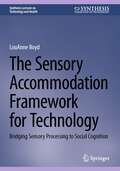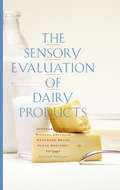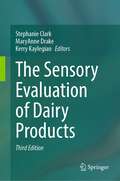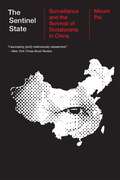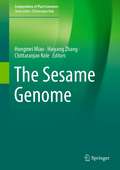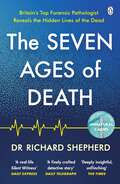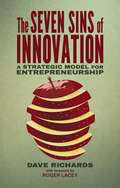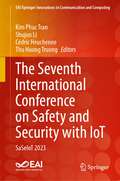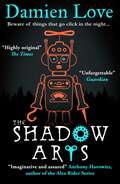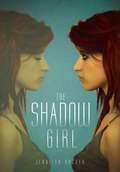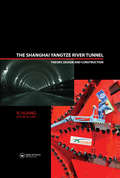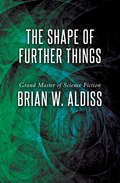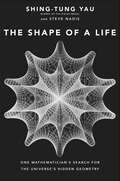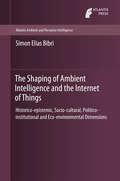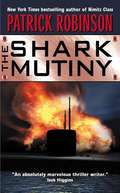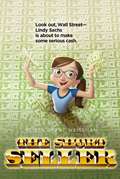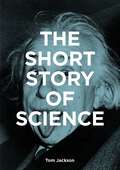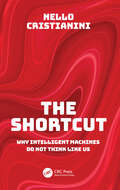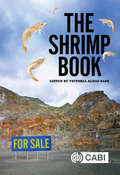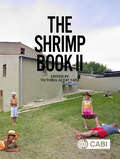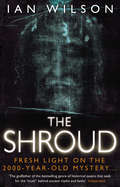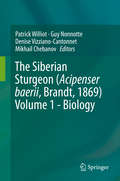- Table View
- List View
The Sensory Accommodation Framework for Technology: Bridging Sensory Processing to Social Cognition (Synthesis Lectures on Technology and Health)
by LouAnne BoydThis book provides a thorough introduction to the many facets of designing technologies for autism, with a particular focus on optimizing visual attention frameworks. This book is designed to provide a detailed overview of several aspects of technology for autism. Each Chapter illustrates different parts of the Sensory Accommodation Framework and provides examples of relevant available technologies. The books first discusses a variety of skills that make up human development as well as a history of autism as a diagnosis and the birth of the neurodiversity movement. It goes on to detail individual types of therapy and how they interact with autism. The systems involved in sensory processing and their specific relation to autism are then explored, including through technologies that have addressed these areas and applications for designers. Readers will learn about designing sensory environments and sensory interactions, such as through virtual reality. This book places a needed emphasis on the hierarchy of information in technology development by exploring visual attention in neurodivergent conditions like autism, ADHD, and dyslexia. It also delves into the relationship between sensory perception and nonverbal communication, the bridge between sensory input and social behavior, and dynamic information. The discussion is rounded out with examinations of temporal processing as and multisensory integration as complicating factors that have existing technological solutions. Finally, the book closes with a summary of the sensory accommodation framework in respect to how each layer offers different user experience goals and specific mechanisms to promote those goals. Readers from a variety of research backgrounds will find this book informative and useful, while designers will learn essential skills for effectively designing autism technologies.
The Sensory Evaluation of Dairy Products
by Stephanie Clark Floyd Bodyfelt Maryanne Drake Michael CostelloThe Sensory Evaluation of Dairy Products, Second Edition is for all who seek a book entirely devoted to sensory evaluation of dairy products and modern applications of the science. It is an excellent scientific reference for training in dairy product evaluation and is a practical guide to the preparation of samples for sensory evaluation. The book contains updates of the original text of the well-received first edition, as well as brand new material. This unique book is designed for professionals involved in many aspects of dairy production, including academic teaching and research, processing, quality assurance, product development and marketing. It is an invaluable tool for those who compete in the annual Collegiate Dairy Product Evaluation Contest.
The Sensory Evaluation of Dairy Products
by Stephanie Clark MaryAnne Drake Kerry KaylegianThe Sensory Evaluation of Dairy Products, Third Edition is for all who seek a book entirely devoted to sensory evaluation of dairy products and modern applications of the science. It is an excellent scientific reference for training in dairy product evaluation and is a practical guide to the preparation of samples for sensory evaluation. The book contains updates of the original text of the well-received first edition, as well as brand new material. This unique book is designed for professionals involved in many aspects of dairy production, including academic teaching and research, processing, quality assurance, product development and marketing. It is an invaluable tool for those who compete in the annual Collegiate Dairy Product Evaluation Contest.
The Sentinel State: Surveillance and the Survival of Dictatorship in China
by Minxin PeiCountering recent hype around technology, a leading expert argues that the endurance of dictatorship in China owes less to facial recognition AI and GPS tracking than to the human resources of the Leninist surveillance state.For decades China watchers argued that economic liberalization and increasing prosperity would bring democracy to the world’s most populous country. Instead, the Communist Party’s grip on power has only strengthened. Why? The answer, Minxin Pei argues, lies in the effectiveness of the Chinese surveillance state. And the source of that effectiveness is not just advanced technology like facial recognition AI and mobile phone tracking. These are important, but what matters more is China’s vast, labor-intensive infrastructure of domestic spying.Central government data on Chinese surveillance is confidential, so Pei turned to local reports, police gazettes, leaked documents, and interviews with exiled dissidents to provide a detailed look at the evolution, organization, and tactics of the surveillance state. Following the 1989 Tiananmen uprising, the Chinese Communist Party invested immense resources in a coercive apparatus operated by a relatively small number of secret police officers capable of mobilizing millions of citizen informants to spy on those suspected of disloyalty. The CCP’s Leninist bureaucratic structure—whereby officials and party activists penetrate every sector of society and the economy, from universities and village committees to delivery companies, telecommunication firms, and Tibetan monasteries—ensures that Beijing’s eyes and ears are truly everywhere.While today’s system is far more robust than that of years past, it is modeled after mass surveillance implemented under Mao Zedong and Chinese emperors centuries ago. Rigorously empirical and rich in historical insight, The Sentinel State is a singular contribution to our knowledge about coercion in the Chinese state and, more generally, the survival strategies of authoritarian regimes.
The Sesame Genome (Compendium of Plant Genomes)
by Chittaranjan Kole Hongmei Miao Haiyang ZhangThis book is the first comprehensive compilation of deliberations on whole genome sequencing of sesame including genome assembly, annotation, structure and synteny analysis, and sequencing of its chloroplast genome and also its wild species. It presents narratives on classical genetics and breeding, tissue culture and genetic transformation, molecular mapping and breeding. Other chapters describe the beneficial components in sesame protein and oil, botanical depictions and cytological features. Prospects of designed breeding in the post-genomics era including gene discovery have also been enumerated.Altogether, the book contains 19 chapters authored by globally reputed experts on the relevant field in this crop. This book is useful to the students, teachers, and scientists in the academia and relevant private companies interested in classical and molecular genetics, biotechnology, breeding, biochemistry, traditional and molecular breeding, and structural and evolutionary genomics. The work is also useful to seed and oil industries.
The Seven Ages of Death: ‘Every chapter is like a detective story’ Telegraph
by Dr Richard ShepherdThe heart-wrenchingly honest new book about life and death from forensic pathologist and bestselling author of UNNATURAL CAUSES, Dr Richard ShepherdA TIMES AND SUNDAY TIMES BOOK OF THE YEAR'Deeply insightful. Unflinching' THE TIMES'A finely-crafted detective story' DAILY TELEGRAPH'Enlightening, strangely uplifting' DAILY MAIL'Fascinating' DAILY EXPRESS_________Dr Richard Shepherd, a medical detective and Britain's top forensic pathologist, shares twenty-four of his most intriguing, enlightening and never-before-told cases.These autopsies, spanning the seven ages of human existence, uncover the secrets not only of how a person died, but also of how they lived.From old to young, murder to misadventure, and illness to accidental death, each body has something to reveal - about its owner's life story, how we age, justice, society, the certainty of death.And, above all, the wonderful marvel of life itself._________Praise for Dr Richard Shepherd'Gripping, grimly fascinating, and I suspect I'll read it at least twice' Evening Standard'A deeply mesmerising memoir of forensic pathology. Human and fascinating' Nigella Lawson'An absolutely brilliant book. I really recommend it, I don't often say that but it's fascinating' Jeremy Vine, BBC Radio 2'Puts the reader at his elbow as he wields the scalpel' Guardian'Fascinating, gruesome yet engrossing' Richard and Judy, Daily Express'Fascinating, insightful, candid, compassionate' Observer
The Seven Sins of Innovation
by Dave RichardsOffers a psychology based model that features seven key determinants of success or failure for innovation and entrepreneurial endeavours. Provides specific recommendations, examples and case studies that demonstrate how individual and group psychology must be engaged effectively to create entrepreneurial cultures capable of powerful innovation.
The Seventh International Conference on Safety and Security with IoT: SaSeIoT 2023 (EAI/Springer Innovations in Communication and Computing)
by Shujun Li Kim Phuc Tran Cédric Heuchenne Thu Huong TruongThis book presents the Fifth International Conference on Safety and Security with IoT (SaSeIoT 2023), which took place Bratislava, Slovakia, October 24-26, 2023. The conference aims to explore not only IoT and its related critical applications but also IoT towards Security and Safety. The conference solicits original and inspiring research contributions from experts, researchers, designers, and practitioners in academia, industry and related fields and provides a common platform to share knowledge, experience and best practices in various domains of IoT.
The Shadow Arts
by Damien Love&‘A dark, mysterious, adrenaline-pumping, rollercoaster of a story&’ Kieran Larwood, author of The Five Realms &‘Clever, funny, exciting and occasionally downright nasty – terrific stuff!&’ Alastair Chisholm, author of Orion Lost &‘A brilliant sequel&’ Jennifer Killick, author of Crater Lake The thrilling sequel to Monstrous Devices – Alex and his grandfather hold the fate of history itself in their hands in a Rick Riordan meets Raiders of the Lost Ark adventure of epic proportions!When Alex&’s grandfather sent him a tin robot with strange powers, his world changed forever… Now, Alex must help his grandfather rescue his old friend Harry, who has fallen into the clutches of a formidable foe. The duo&’s mission takes them on a desperate dash across Europe, chasing down the mystery Harry was investigating when he disappeared. But can Alex work out the ancient secret that lies hidden in the depths of Germany&’s Black Forest and harness the powers of his robot before it&’s too late? Innocent lives – and even history itself – are at stake.
The Shadow Girl
by Jennifer ArcherSometimes I forget for an hour or two that she's with me. Sometimes I convince myself that she was only a dream. Or that I'm crazy. For as long as Lily Winston can remember, she has never been alone. Iris, a shadowy figure who mimics Lily's movements and whispers in her ear, is with her always—but invisible to the rest of the world. Iris is Lily's secret. But when Lily's father is killed in a tragic accident, his cryptic final words suggest that he and Lily's mother have been keeping secrets of their own. Suddenly, Iris begins pushing Lily more than ever, possessing her thoughts and urging her to put together the pieces of a strange puzzle her father left behind. As she searches for answers, Lily finds herself drawn to Ty Collier, a mysterious new boy in town. Together, Lily and Ty must untangle a web of deception to discover the truth about her family, Iris . and Lily's own identity.
The Shanghai Yangtze River Tunnel: Theory, Design and Construction
by R. HuangOne of the world's currently largests tunnel projects is under construction at the Yangtze River estuary: the Shanghai Yangtze River Tunnel project, with its length of 8950 m and a diameter of 15.43 m. The Shanghai Yangtze River Tunnel. Theory, Design and Construction, which was presented as a special issue at the occasion of the 6th International Symposium on Geotechnical Aspects of Underground Construction in Soft Ground.
The Shape of Further Things
by Brian W. AldissThe sci-fi author behind Steven Spielberg&’s A.I. shares his thoughts on the present, the future, and his own work and life. &“We are infinitely rich, yet we mess about with penny-in-the-slot machines,&” writes Brian W. Aldiss in this autobiographical work written over the course of one month. From his Oxfordshire home, he ruminates on dreams, education, the role of technology in our lives, the rise and function of science fiction, and a variety of other topics. The Shape of Further Things is a window into the life and mind of a Science Fiction Grand Master. Winner of two Hugo Awards, one Nebula Award, and named a Grand Master by the Science Fiction Writers of America, Brian W. Aldiss challenged readers&’ minds for over fifty years with literate, thought-provoking, and inventive science fiction. &“This short book flows with large ideas, a time capsule now from the grandest of writers.&” —SF Site
The Shape of a Life: One Mathematician's Search for the Universe's Hidden Geometry
by Shing-Tung Yau Steve NadisA Fields medalist recounts his lifelong effort to uncover the geometric shape—the Calabi-Yau manifold—that may store the hidden dimensions of our universe.Harvard geometer Shing-Tung Yau has provided a mathematical foundation for string theory, offered new insights into black holes, and mathematically demonstrated the stability of our universe. In this autobiography, Yau reflects on his improbable journey to becoming one of the world’s most distinguished mathematicians. Beginning with an impoverished childhood in China and Hong Kong, Yau takes readers through his doctoral studies at Berkeley during the height of the Vietnam War protests, his Fields Medal–winning proof of the Calabi conjecture, his return to China, and his pioneering work in geometric analysis. This new branch of geometry, which Yau built up with his friends and colleagues, has paved the way for solutions to several important and previously intransigent problems.With complicated ideas explained for a broad audience, this book offers not only insights into the life of an eminent mathematician, but also an accessible way to understand advanced and highly abstract concepts in mathematics and theoretical physics.“The remarkable story of one of the world’s most accomplished mathematicians . . . Yau’s personal journey—from escaping China as a youngster, leading a gang outside Hong Kong, becoming captivated by mathematics, to making breakthroughs that thrust him on the world stage—inspires us all with humankind’s irrepressible spirit of discovery.” —Brian Greene, New York Times–bestselling author of The Elegant Universe“An unexpectedly intimate look into a highly accomplished man, his colleagues and friends, the development of a new field of geometric analysis, and a glimpse into a truly uncommon mind.” —The Boston Globe“Engaging, eminently readable. . . . For those with a taste for elegant and largely jargon-free explanations of mathematics, The Shape of a Life promises hours of rewarding reading.” —American Scientist
The Shaping of Ambient Intelligence and the Internet of Things
by Simon Elias BibriRecent advances in ICT have given rise to new socially disruptive technologies: AmI and the IoT, marking a major technological change which may lead to a drastic transformation of the technological ecosystem in all its complexity, as well as to a major alteration in technology use and thus daily living. Yet no work has systematically explored AmI and the IoT as advances in science and technology (S&T) and sociotechnical visions in light of their nature, underpinning, and practices along with their implications for individual and social wellbeing and for environmental health. AmI and the IoT raise new sets of questions: In what way can we conceptualize such technologies? How can we evaluate their benefits and risks? How should science-based technology and society's politics relate? Are science-based technology and society converging in new ways? It is with such questions that this book is concerned. Positioned within the research field of Science and Technology Studies (STS), which encourages analyses whose approaches are drawn from a variety of disciplinary perspectives, this book amalgamates an investigation of AmI and the IoT technologies based on a unique approach to cross-disciplinary integration; their ethical, social, cultural, political, and environmental effects; and a philosophical analysis and evaluation of the implications of such effects. An interdisciplinary approach is indeed necessary to understand the complex issue of scientific and technological innovations that S&T are not the only driving forces of the modern, high-tech society, as well as to respond holistically, knowledgeably, reflectively, and critically to the most pressing issues and significant challenges of the modern world. This book is the first systematic study on how AmI and the IoT applications of scientific discovery link up with other developments in the spheres of the European society, including culture, politics, policy, ethics and ecological philosophy. It situates AmI and the IoT developments and innovations as modernist science-based technology enterprises in a volatile and tense relationship with an inherently contingent, heterogeneous, fractured, conflictual, plural, and reflexive postmodern social world. The issue's topicality results in a book of interest to a wide readership in science, industry, politics, and policymaking, as well as of recommendation to anyone interested in learning the sociology, philosophy, and history of AmI and the IoT technologies, or to those who would like to better understand some of the ethical, environmental, social, cultural, and political dilemmas to what has been labeled the technologies of the 21st century.
The Shark Mutiny (Arnold Morgan #5)
by Patrick RobinsonAn oil tanker mysteriously explodes in the Persian Gulf. Then a second . . . and a third. To the President's National Security Adviser Admiral Arnold Morgan it is more than a tragic coincidence-it is a brazen act of aggression that must not stand. In partnership with Iran, the Chinese navy has mined the Strait of Hormuz, intending to hold the world's oil supply hostage. Now eighty percent of America's active sea power is being mobilized-including U.S.S. Shark, an aging nuclear submarine on its final tour of duty-to dismantle a deadly alliance between two powerful enemies. But something goes terribly wrong during a bold retaliatory SEAL assault on China's Indian Ocean power plants-a disaster that spawns death, disbelief, rage . . . and rebellion. And with a volatile world on the brink of catastrophic conflict, the commanders of a nuclear boat in the twilight of glory must confront a nightmare as devastating as it is unthinkable: mutiny!
The Shipwreck Hunter: A Lifetime Of Extraordinary Discoveries On The Ocean Floor
by David L. MearnsThis gripping memoir by the world’s foremost marine geologist is an enthralling blend of maritime history, popular science, and Clive Cussler–style adventure. David L. Mearns has discovered some of the world’s most fascinating and elusive shipwrecks. From the mighty battleship HMS Hood (sunk in a pyrrhic duel with the Bismarck) to solving the mystery of HMAS Sydney, to the crumbling wooden skeletons of Vasco da Gama’s sixteenth century fleet, Mearns has searched for and found dozens of sunken vessels in every ocean of the world. The Shipwreck Hunter chronicles his most intriguing finds. It describes the extraordinary techniques used, the detailed research and mid-ocean stamina (and courage) required to find a wreck thousands of feet beneath the sea, as well as the moving human stories that lie behind each of these oceanic tragedies. Combining the adventuring derringdo of Indiana Jones with the precision of a scientist, The Shipwreck Hunter opens an illuminating porthole into the shadowy depths of the ocean.
The Short Seller
by Elissa Brent WeissmanLook out Wall Street--Lindy Sachs is about to make some serious cash. A twelve-year-old takes on the stock market in this money-minded middle grade novel. It all starts when seventh grader Lindy Sachs is granted $100 and access to her father's online trading account as a way to alleviate her boredom while she's home sick from school. Lindy learns something immediately--she is very, very good at e-trading. Her $100 becomes $200. Then $400. And more. With trading talent and access to her parents' savings, the opportunity to make some real dough is too tempting to pass up. In fact, given how well Lindy's stocks are doing, it would be a disservice to not invest it all... Right?
The Short Seller
by Elissa Brent WeissmanA twelve-year-old takes on the stock market in this money-minded middle grade novel that Publishers Weekly calls "a smart pick."It all starts when seventh grader Lindy Sachs is granted one hundred dollars and access to her father's online trading account as a way to alleviate her boredom while she's home sick from school. Lindy learns something immediately--she is very, very good at e-trading. Her one hundred dollars soon becomes two hundred dollars. Then four hundred. And more. With trading talent and access to her parents' savings, the opportunity to make some real dough is too tempting to pass up. In fact, given how well Lindy's stocks are doing, it would be a disservice to not invest it all...Right?
The Short Story of Science: A Pocket Guide to Key Histories, Experiments, Theories, Instruments and Methods
by Tom Jackson Mark Fletcher'Nothing in life is to be feared. It is only to be understood. Now is the time to understand more, so that we may fear less' Marie CurieThe Short Story of Science is a new introduction to the complete subject of science. Covering 60 key experiments, from Archimedes' investigations of buoyancy to the discovery of dark matter, and then linking these to the history of science, as well as to the key theories and methods, the book simplifies and explains all the key breakthroughs.Accessible and concise, generously illustrated throughout, and with all the essential information presented without jargon, readers are given all the tools they need to enjoy the fascinating history of scientific knowledge.
The Short Story of Science: A Pocket Guide to Key Histories, Experiments, Theories, Instruments and Methods
by Tom Jackson Mark Fletcher'Nothing in life is to be feared. It is only to be understood. Now is the time to understand more, so that we may fear less' Marie CurieThe Short Story of Science is a new introduction to the complete subject of science. Covering 60 key experiments, from Archimedes' investigations of buoyancy to the discovery of dark matter, and then linking these to the history of science, as well as to the key theories and methods, the book simplifies and explains all the key breakthroughs.Accessible and concise, generously illustrated throughout, and with all the essential information presented without jargon, readers are given all the tools they need to enjoy the fascinating history of scientific knowledge.
The Shortcut: Why Intelligent Machines Do Not Think Like Us
by Nello CristianiniAn influential scientist in the field of artificial intelligence (AI) explains its fundamental concepts and how it is changing culture and society.A particular form of AI is now embedded in our tech, our infrastructure, and our lives. How did it get there? Where and why should we be concerned? And what should we do now? The Shortcut: Why Intelligent Machines Do Not Think Like Us provides an accessible yet probing exposure of AI in its prevalent form today, proposing a new narrative to connect and make sense of events that have happened in the recent tumultuous past, and enabling us to think soberly about the road ahead.This book is divided into ten carefully crafted and easily digestible chapters. Each chapter grapples with an important question for AI. Ranging from the scientific concepts that underpin the technology to wider implications for society, it develops a unified description using tools from different disciplines and avoiding unnecessary abstractions or words that end with -ism. The book uses real examples wherever possible, introducing the reader to the people who have created some of these technologies and to ideas shaping modern society that originate from the technical side of AI. It contains important practical advice about how we should approach AI in the future without promoting exaggerated hypes or fears.Entertaining and disturbing but always thoughtful, The Shortcut confronts the hidden logic of AI while preserving a space for human dignity. It is essential reading for anyone with an interest in AI, the history of technology, and the history of ideas. General readers will come away much more informed about how AI really works today and what we should do next.
The Shrimp Book
by V. Alday-SanzThis definitive book on The Shrimp is the result of the contributions of 67 international authors. It contains a wealth of scientific knowledge that can usually only be located in a fragmented manner in specialised journals or presented at industry conferences that rarely reach a wide audience. It brings together the worlds of aquaculture science and industry production. The book includes descriptions of farming practices and the actual implementation of new technologies. The content is structured into six parts: shrimp farming; the shrimp as an animal; current farming practices; optimisation of feeds; biosecurity; and post-harvest. It is addressed to shrimp producers and service providers, researchers and students. It compiles, in one single volume, the full depth of the academic perspective together with the most recent developments in field practice. This book illustrates the important interaction between the academic and industry worlds. It facilitates access to information, knowledge and new ideas as well as bringing in material for debate and discussion.
The Shrimp Book II
by Victoria Alday-SanzThis new volume of The Shrimp Book is complementary to the first, bringing together new knowledge, new technologies, new perspectives and new ideas from 98 international authors, from both academia and industry. While Volume I was conceived from the academic experience, this new volume originates from the farming experience. There are six parts. Part I on sustainability and insurance is followed by Part II on the shrimp as an animal - functional anatomy, its genome and genetics. Part III covers production systems - microbial, water and oxygen management - and Part IV feeds and feeding including feeding behaviour and automatic feeders. Part V is on biosecurity covering shrimp response to virus, epigenetic management, new and old pathogens, and disinfectants. Finally, there is Part VI on post-harvest issues looking into trade and quality control concerns. The Shrimp Book II is addressed to shrimp producers and service providers, researchers and students. It brings together academic perspectives and the most recent development in field practices.
The Shroud: Fresh Light on the 2000 Year Old Mystery
by Ian WilsonTwo decades after radiocarbon dating declared the Turin Shroud a mediaeval fake, brand-new historical discoveries strongly suggest that this famous cloth, with its extraordinary photographic imprint, is genuinely Christ's shroud after all.In 1978 in his international bestseller The Turin Shroud Ian Wilson ignited worldwide public debate with his compelling case endorsing the shroud's authenticity. Now, 30 years later, he has completely rewritten and updated his earlier book to provide fresh evidence to support his original argument. Shroud boldly challenges the current post-radiocarbon dating view - that it is a fake. By arguing his case brilliantly and provocatively, Ian Wilson once more throws the matter into the public arena for further debate and controversy.
The Siberian Sturgeon (Acipenser baerii, Brandt, 1869) Volume 1 - Biology
by Patrick Williot Guy Nonnotte Denise Vizziano-Cantonnet Mikhail ChebanovThe biology of the Siberian sturgeon, Acipenser baerii Brandt 1869, has become a very attractive subject of investigation for biologists since the 1980s. This volume 1 is part of a two-volume set devoted to the species, the second of which focuses on farming. The present volume is divided into three parts: Biology and ecology, Biology and physiology of reproduction, and Ecophysiology, i.e. adaptation to the environment. The first part addresses a broad range of topics, such as: the ecology, including a new approach to species-specificity, a new insight on the mineralization of vertebral elements, two approaches to sex determination, transposable elements in the gonads, early ontogeny, olfaction and gustation, nutrition and swimming. The second part includes neurochemical and anatomical descriptions of the central nervous system and an updated version of the oogenesis, the characteristics of both sperm and spermatozoa, and a synthesis on gonadal steroids (synthesis, plasmatic levels and biological activities). In turn, the third part reveals how the physiology of the species changes depending on environmental factors such as oxygen, ammonia, and nitrite. Some fundamental consequences of ammonia are developed (sublethal and lethal levels, effects on gill epithelium and haematology, acid-base balance, on AA and adenyl nucleotides levels in plasma, brain and muscle tissue). In addition, the book includes two methodological chapters dealing with fish dorsal aortic cannulation and respiration physiology.
